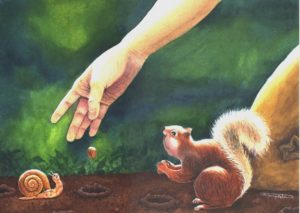A Squirrel’s Guide to Homegrown Sustenance in the North
By David Fried
Inspired by The Man Who Planted Trees, a book by John Giono and Bill Mackentley (my mentor), I planted black walnuts, Korean pine nuts, hazelberts and shagbark hickories on our hill in northern Vermont. They grew and started making nuts in five to twelve years. The hazelberts were the quickest, and the shagbarks the slowest, but they are very grand.
If I were a squirrel burying (planting) nuts, I would plant them the same time they fall. They have been doing this a long time, so I follow their example and plant mine right away, too.
They forget where they plant them. I mark them with stakes in prepared beds and record the name of the parent tree on a map and label each bed. I also cover the nuts with hardware cloth, with extra on all sides, from a roll, so those who would ‘have at them” have less of a chance. Just like when the squirrels plant, a lot of ours come up, and they are most noticeable at the end of summer. I leave the hardware cloth barrier on the first year but make sure to take it off by gently sliding it over their tops when the leaves have fallen in November, or April before they grow new ones! When they are two or three years old, I dig them up and plant them all around the place.
Hazelberts are planted about six feet apart, pine nuts about 20, shagbarks and black walnuts about 30 feet apart. This gives them room to grow, so they will not be too far apart for pollination, or so the squirrel will not have too hard a time leaping from tree to tree.
Always keep the seedlings marked with a colorful flag and a cedar post or large stick. This gives the mower a better reputation and your tree a better chance of making it to the nut stage.
Always plant at least three of the same species. If one dies for some reason, down the road of time, you still have two maturing trees ready to pollinate each other, and then you get the nuts.
Here are our harvesting secrets. Know that the squirrels are waiting all year for this moment. For you, it is a hobby, for them it is survival. You must notice when the first few heavy or filled ones are falling and get crackin! Pluck the hazelbert clusters off the large bush and store them in breathable containers and spread them out to dry in the husks, indoors and in a squirrel-proof building or wire enclosure. They are ready to harvest when they begin to turn from light tan to medium tan. They will continue to ripen indoors, but if you wait until they are good and dark brown on the bush, the squirrel will get them first.
The squirrel begins knocking off the whole nut pine cones, and they all fall heavy to the earth. He will sit and start pulling out the large nuts and sit cracking them on a shelf or air conditioner. This is your cue to check under the tree and gather all the rest of the cones. Store these inside and crack them to eat as you want them, or plant some outside, in partial shade, to start a new pine nut grove.
We use a “nut wizard” to roll along the ground rolling up the green and fragrant black walnuts (without bending over to pick up each one which is much easier on the back) which we then open, watching them fall into a bucket. You need to stomp on the green husk on pavement or gravel, and you are left with the hard black interior. After a bucket is filled with nuts in the shell, I fill this with water and whack it around with a two-by-four to help clean them and get some of that black juice off. (Wear gloves, as they stain your hands for weeks, which is why they make a great natural dye.) Now spread them to dry in a squirrel-free zone of a home or workshop. They “cure” and are ready to eat in two or three months and keep for two or three years in the shell. You can use a hammer and a rock or a vise, but we use a special black walnut cracker to gently open each shell and get to the tasty nutmeats inside. Best stored within their shells at room temperature, once cracked and open, keep the ones you don’t eat in the fridge.
Someone visiting our farm nursery once said, after her tour, “If I was a squirrel, I’d live here!”
Growing nuts in the north asks for a combination of patience, skill, timing and enjoying aerial acrobatics. Nut trees are big producers of high quality protein we can grow here in the north, and there is plenty to go around for all.
David Fried of is the owner of Elmore Roots, a fruit and nut tree nursery in Elmore, Vermont, where you can also pick up a “nut wizard” and a black walnut cracker.









Leave a Reply